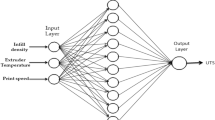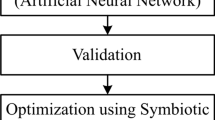Abstract
Fused deposition modelling is a proven technology for the fabrication of both aesthetic and functional prototypes. The obtainable roughness is the most limiting aspect for its application. The prediction of surface quality is an essential tool for the diffusion of this technology, in fact at product development stage, it allows to comply with design specifications and in process planning it is useful to determine manufacturing strategies. The existing models are not robust enough in predicting roughness parameters for all deposition angles, in particular for near horizontal walls. The aim of this work is to determine roughness parameters models reliable over the entire part surface. This purpose is pursued using a feed-forward neural network to fit experimental data. By the utilisation of an evaluation function, the best solution has been found. This has been obtained using a feed-forward neural network for fitting the experimental data. The best solution has been founded by using an evaluation function that we constructed. The validation proved the robustness of the model found to process parameters’ variation and its applicability to different FDM machines and materials.
Similar content being viewed by others
References
Gebhardt A (2003) Rapid prototyping. Hanser, Munich
Chua CK, Leong KF, Lim CS (2010) Rapid prototyping: principles and applications, 3rd edn. World Scientific, Singapore
Wohlers TT, (2008) Wohlers Report 2008: Executive Summary. Colorado, USA
Armillotta A (2006) Assessment of surface quality on textured FDM prototypes. Rapid Prototyp J 12:35–41
Perez CJL, Vivancos J, Sebastiàn MA (2001) Surface roughness analysis in layered forming processes. Precis Eng 25:1–12
Campbell RI, Martorelli M, Lee HS (2002) Surface roughness visualization for rapid prototyping models. Comput Aided Des 34:717–725
Reeves PE, Cobb RC, (1995) Surface deviation modelling of LTM processes—a comparative analysis. In: Proceedings of the Fifth European Conference on Rapid Prototyping and Manufacturing, University of Nottingham, Nottingham
Ahn D, Kim H, Lee S (2009) Surface roughness prediction using measured data and interpolation in layered manufacturing. J Mater Process Technol 209:664–671
Ahn DK, Kweon JH, Kwon S, Song J, Lee S (2009) Representation of surface roughness in fused deposition modelling. J Mater Process Technol 209:5593–5600
Pandey PM, Reddy NV, Dhande SG (2003) Real time adaptive slicing for fused deposition modeling. Int J Mach Tools Manuf 43:61–71
Boschetto A, Giordano V, Veniali F (2011) Modelling micro geometrical profile in fused deposition process. Int J Adv Manuf Technol. doi:10.1007/s00170-011-3744-1
Kohonen T (1988) An introduction to neural computing. Neural Netw 1:3–16
Kohli A, Dixit US (2005) A neural-network-based methodology for the prediction of surface roughness in a turning process. Int J Adv Manuf Technol. doi:10.1007/s00170-003-1810-z
Lee SS, Chen JC (2003) On-line surface roughness system using artificial neural networks system in turning operations. Int J Adv Manuf Technol. doi:10.1007/s00170-002-1511-z
Karayel D (2008) Prediction and control of surface roughness in CNC lathe using artificial neural network. J Mater Process Technol 209:3125–3137
Yang SH, Natarajan U, Sekar M, Palani S (2010) Prediction of surface roughness in turning operations by computer vision using neural network trained by differential evolution algorithm. Int J Adv Manuf Technol. doi:10.1007/s00170-010-2668-5
Sonar DK, Dixit US, Ojha DK (2006) The application of radial basis function neural network for predicting the surface roughness in a turning process. Int J Adv Manuf Technol. doi:10.1007/s00170-004-2258-5
Coit DW, Jackson BT, Smith AE (1998) Static neural network process models: considerations and case studies. Int J Prod Res 36:2953–2967
EL-Mounayri H, Briceno JF (2010) A new artificial network approach to modeling ball-end milling. Int J Adv Manuf Technol. doi:10.1007/s00170-009-2217-2
Muñoz-Escalona P, Maropoulos PG (2010) Artificial neural networks for surface roughness prediction when face milling AI 7075-t7351. J Mater Eng Perform. doi:10.1007/s1665-009-9452-4
Balic J (2004) Neural-network based numerical control milling machine. J Intell Robot Syst 40:343–358
Ozcelik B, Oktem H, Kurtarn H (2005) Optimum surface roughness in end milling inconel 718 by coupling neural network model and genetic algorithm. Int J Adv Manuf Technol. doi:10.1007/s00170-004-2175-7
Oktem H, Erzurumlu T, Erzinznli F (2006) Prediction of minimum surface roughness in end milling mold parts using neural and genetic algorithm. Mater Design 27:735–744
Benardos PG, Vosniakos GC (2002) Prediction of surface roughness in CNC face milling using neural networks and Taguchi’s design of experiments. Robot Comput Integr Manuf 18:343–354
Quintana G, Garcia-Romeu ML, Ciurana J (2011) Surface roughness monitoring application based on artificial neural networks for ball-end milling operations. J Intell Manuf. doi:10.1007/s1084-009-0323-5
Sanjay C, Jyothi C (2006) A study of surface roughness in drilling using mathematical analysis and neural networks. Int J Adv Manuf Technol. doi:10.1007/s00170-005-2538-8
Markopoulos AP, Manolakos DE, Vaxevanidis NM (2008) Artificial neural network models for the prediction of surface roughness in electrical discharge machining. Int J Adv Manuf Technol. doi:10.1007/s10845-008-0081-9
Mahapatra SS, Sood AK (2012) Bayesian regularization-based Levenberg–Marquardt neural model combined with BFOA for improving surface finish of FDM processed part. Int J Adv Manuf Technol 60:1223–1235
Huang SH, Zhang HC (1995) Neural-expert hybrid approach for intelligent manufacturing: a survey. Comput Ind 26:107–126
Hayken S (1999) Neural networks: a comprehensive foundation. Prentice-Hall, Englewood Cliffs
Gareta R, Romeo LM, Gil A (2006) Forecasting of electricity prices with neural Networks. Energy Convers Manag 47:1770–1778
Karatas C, Sozen A, Dulek E (2009) Modelling of residual stresses in the shot peened material C-1020 by artificial neural network. Expert Syst Appl 36:3514–3521
Asiltürk I, Çunkas M (2011) Modeling and prediction of surface roughness in turning operations using artificial neural network and multiple regression method. Expert Syst Appl 38:5826–5832
Pala M, Caglar N, Elmas M, Cevik A, Saribiyik M (2008) Dynamic soil structure interaction analysis of neural network. Constr Build Mater 22:330–342
Lawrence J (1994) Introduction to neural networks: design, theory and applications, 6th edn. California Scientific Software, Nevada City
Haykin S (1999) Neural networks: a comprehensive foundation, 2nd edn. Prentice-Hall, Englewood Cliffs
Leong KF, Chua CK (1996) A study of stereolithography file errors and repair, part 1—generic solutions. Int J Adv Manuf Technol 12:407–414
Leong KF, Chua CK (1996) A study of stereolithography file errors and repair, part 2—special cases. Int J Adv Manuf Technol 12:415–422
Bordoni M, Boschetto A (2012) Thickening of surfaces for direct additive manufacturing fabrication. Rapid Prototyp J 18:308–318
ISO/DTS 16610-22: 2006 Geometrical product specifications (GPS)—filtration—linear profile filters: Spline filters, pp. 1–6
Whitehouse DJ (1994) Handbook of surface metrology. IOP Publishing Ltd., Bristol
Cybenko G (1989) Approximation by superpositions of a sigmoidal function. Math Control Signals Syst 2:303–314
Basterrech S, Mohammed S, Rubino G, Soliman M (2011) Levenberg–Marquardt training algorithms for random neural networks. Comput J 54:125–135
Principe JC, Euliano NR, Lefebvre WC, (2000) Neural and adaptive systems: fundamentals through simulations. Wiley, New York
ISO 4287:1997. Geometrical product specifications (GPS)—surface texture: profile method—terms, definitions and surface texture parameters, pp. 1–25
Costa A (1984) Examples of a complete minimal immersion in R 3 of genus one and three embedded ends. Bil Soc Bras Mat 15:47–54
Author information
Authors and Affiliations
Corresponding author
Rights and permissions
About this article
Cite this article
Boschetto, A., Giordano, V. & Veniali, F. Surface roughness prediction in fused deposition modelling by neural networks. Int J Adv Manuf Technol 67, 2727–2742 (2013). https://doi.org/10.1007/s00170-012-4687-x
Received:
Accepted:
Published:
Issue Date:
DOI: https://doi.org/10.1007/s00170-012-4687-x




